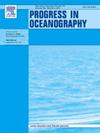Temporal variability of phytoplankton biomass and algae blooms in the open Black Sea
IF 3.6
3区 地球科学
Q1 OCEANOGRAPHY
引用次数: 0
Abstract
This study investigated long-term changes and seasonality of phytoplankton carbon biomass and algae blooms in the open Black Sea surface layer within the post-eutrophication period (1998–2022). Phytoplankton carbon biomass was calculated from satellite-derived chlorophyll a concentration using carbon-to-chlorophyll a ratio from in situ measurements. This allowed us to identify the months experiencing algal blooms within this period (August – November). We show that phytoplankton biomass and bloom frequency were negatively coupled to the vertical density gradient, suggesting that these features were driven possibly by large diatoms harvesting nutrients from deeper depths. Our results also suggest that photoinhibition, together with high vertical density gradients, could reduce phytoplankton biomass and blooms in the surface layer during summer, with the first signs of alleviation in August. Our study also discusses the large differences in drivers of the phytoplankton community between three distinct periods: the pre-eutrophication (before the early 1970 s), intense phase of eutrophication (mid-1980 s – early 1990 s) and post-eutrophication, and conclude that decadal changes in climate and nutrient inputs caused substantial changes in phytoplankton biomass and algae blooms.
黑海开阔海域浮游植物生物量和藻类大量繁殖的时间变异性
本研究研究了富营养化后(1998-2022年)黑海表层浮游植物碳生物量和藻华的长期变化和季节性。浮游植物的碳生物量是利用原位测量的碳与叶绿素a的比值,从卫星获得的叶绿素a浓度计算出来的。这使我们能够确定在这一时期(8月至11月)经历藻华的月份。研究表明,浮游植物生物量和水华频率与垂直密度梯度呈负相关,表明这些特征可能是由大型硅藻从较深的深度获取营养物质驱动的。我们的研究结果还表明,光抑制与高垂直密度梯度一起,可以减少夏季表层浮游植物生物量和华度,并在8月份出现缓解迹象。我们的研究还讨论了三个不同时期浮游植物群落驱动因素的巨大差异:富营养化前(1970年代早期 s之前),富营养化强烈阶段(1980年代中期至1990年代早期)和富营养化后,并得出结论,气候和养分输入的年代际变化导致浮游植物生物量和藻华的实质性变化。
本文章由计算机程序翻译,如有差异,请以英文原文为准。
求助全文
约1分钟内获得全文
求助全文
来源期刊

Progress in Oceanography
地学-海洋学
CiteScore
7.20
自引率
4.90%
发文量
138
审稿时长
3 months
期刊介绍:
Progress in Oceanography publishes the longer, more comprehensive papers that most oceanographers feel are necessary, on occasion, to do justice to their work. Contributions are generally either a review of an aspect of oceanography or a treatise on an expanding oceanographic subject. The articles cover the entire spectrum of disciplines within the science of oceanography. Occasionally volumes are devoted to collections of papers and conference proceedings of exceptional interest. Essential reading for all oceanographers.
 求助内容:
求助内容: 应助结果提醒方式:
应助结果提醒方式:


